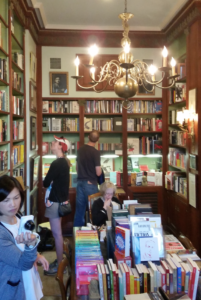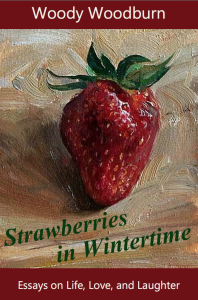 Woody’s highly anticipated new book “STRAWBERRIES IN WINTERTIME: Essays on Life, Love, and Laughter” is NOW available! Order your signed copy HERE!
Woody’s highly anticipated new book “STRAWBERRIES IN WINTERTIME: Essays on Life, Love, and Laughter” is NOW available! Order your signed copy HERE!
* * *
Going Backstage at Tennessee’s House
During Act One, last week, our foursome made a pilgrimage to legendary playwright Tennessee Williams’ home in New Orleans.
Flicker the lobby lights. Intermission is over. Raise the curtain.
Act Two:
Brobson Lutz, wearing round wire-rimmed glasses and a button-down collar shirt and carrying an armload of papers and folders, came into focus like a university professor.
My daughter, son-in-law, son and I were standing in the middle of Dumaine Street, in the middle of the French Quarter, “star” gazing at The Tennessee Williams House. Despite being an official Literary Landmark, the two-story yellow home with a green ironwork balcony is unimpressive in its ordinariness.
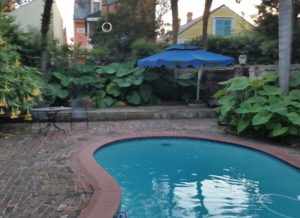
Tennessee Williams’ splendorous pool in the French Quarter.
Then something extraordinary happened.
“Would you like to see the swimming pool in back?” Lutz asked.
Beignets from Café du Monde would not have been a more enticing offer.
Lutz, it turns out, was Williams’ next-door neighbor – and, for the last two years of William’s life, his landlord. In 1981, Lutz bought Williams’ house – which was divided into six apartments – with the stipulation the writer could keep Apartment B for $100 a month for the rest of his life.
“I think that’s what sealed the deal,” Lutz told us.
Apartment B, on the second floor in the front, is where Williams had lived – and written – off and on since originally buying the property in 1962.
“He came here three or four times a year,” Lutz recalled of the time he knew Williams. “He’d stay about a week, sometimes just one day, and then he’d be gone again. He spent most of his time in Key West.”
Williams died at age 71 on Feb. 25, 1983, in a Manhattan hotel suite after choking on the cap of a medicine bottle. It was not the final curtain call he wished for, writing in his 1975 autobiography, “Memoirs”: “I hope to die in my sleep . . . in this beautiful big brass bed in my New Orleans apartment.”
He wrote those words in Apartment B at 1014 Dumaine St.
Lutz was unable to show us the inside of The Tennessee Williams House because it has tenants, including in Apartment B. However, he took us around back to see Williams’ swimming pool.
While the front of the house is modest, the courtyard is splendorous. A red brick deck surrounds the kidney-shaped pool and abundant foliage surrounds it all.
“Many people thought Tennessee Williams put in the pool, but it had already been put in,” Brobson explained, further noting: “Legend has it he would swim here every day he was in New Orleans – even in winter.”
On this lovely winter day our host invited us to stay for wine, and more stories, on his patio next door. It was equal parts Southern hospitality and serendipity.
“Is a nice Chardonnay okay?” he asked. Tap water would have been fine; we were thirsty for more Tennessee tales. Lutz was tall to the task, his storytelling made all the more mesmerizing by a New Orleans accent thick as gumbo.
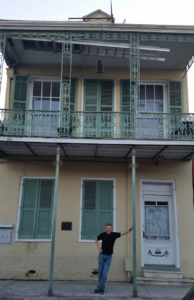
The Tennessee Williams House, an official Literary Landmark in the French Quarter.
We learned our professorial-looking host is actually a physician, specializing in infectious disease. He also has an infectious charm.
As for Williams’ charm, Lutz answered: “Was he a friendly guy? He was more of a friendly drunk.”
About Williams’ death, Lutz recalled: “Twelve hours later an armed guard arrived here. A week later everything was moved out to the Florida Keys.”
At one point we were joined by Lutz’s dog, Kat, which reminded me of the title of Williams’ famous play, “Cat on a Hot Tin Roof.” This, in turn, led me to ask Lutz if he liked Williams’ writing.
“I prefer his short stories to his plays,” he said.
An avid art collector, Lutz surprisingly has only one collectable Tennessee Williams book, a 1954 first-edition of “One Arm,” which was Williams’ first volume of short fiction.
More surprisingly, considering Lutz was Williams’ neighbor and landlord, it is unsigned by the author.
“Do you wish you’d thought to ask him to sign it?” one of us asked.
“Yep,” Dr. Brobson Lutz answered, his wry smile speaking volumes.
* * *
Woody Woodburn writes a weekly column for The Ventura County Star and can be contacted at WoodyWriter@gmail.com.
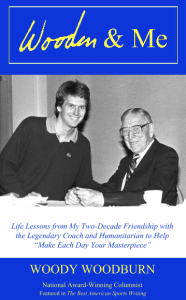 Check out my new memoir WOODEN & ME: Life Lessons from My Two-Decade Friendship with the Legendary Coach and Humanitarian to Help “Make Each Day Your Masterpiece”
Check out my new memoir WOODEN & ME: Life Lessons from My Two-Decade Friendship with the Legendary Coach and Humanitarian to Help “Make Each Day Your Masterpiece”
- Personalized signed copies are available at WoodyWoodburn.com
- Unsigned paperbacks or Kindle ebook can be purchased here at Amazon

